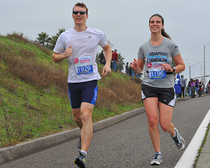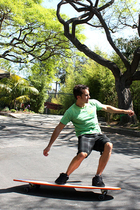
Figure skating
Figure skating is a sport in which individuals, duos, or groups perform on figure skates on ice. It was the first winter sport to be included in the Olympic Games, when contested at the 1908 Olympics in London. The four Olympic disciplines are men's singles, ladies' singles, pair skating, and ice dance; the non-Olympic disciplines include synchronized skating, Theater on Ice, and four skating. From intermediate through senior-level competition, skaters generally perform two programs (the short program and the free skate), which, depending on the discipline, may include spins, jumps, moves in the field, lifts, throw jumps, death spirals, and other elements or moves. The blade of a figure skate has a groove on the bottom creating two distinct edges: inside and outside. Judges prefer that skaters glide on one edge of the blade and not on both at the same time, which is referred to as a "flat edge". Skates used in singles and pair skating have a set of large, jagged teeth called a "toe pick" on the front of each blade. The toe picks are mainly used to help launch the skater into the air for the take-off when performing jumps. Ice dance blades have smaller toe picks than blades used for the other disciplines. During a spin, skaters use the "sweet spot" of the blade, formally called a rocker, which is the roundest portion of the blade, just behind the toe pick and near the middle of the blade. Figure skaters compete at various levels from beginner up to the Olympic level (senior) at local, regional, sectional, national, and international competitions. The International Skating Union (ISU) regulates international figure skating judging and competitions. These include the Winter Olympics, the World Championships, the World Junior Championships, the European Championships, the Four Continents Championships, the Grand Prix series (senior and junior), and the ISU Challenger Series. The sport is also associated with show business. Major competitions generally conclude with exhibition galas, in which the top skaters from each discipline perform non-competitive programs. Many skaters, both during and after their competitive careers, also skate in ice shows, which run during the competitive season and the off-season.
See all
0
0

Running
Running is a method of terrestrial locomotion allowing humans and other animals to move rapidly on foot. Running is a type of gait characterized by an aerial phase in which all feet are above the ground (though there are exceptions). This is in contrast to walking, where one foot is always in contact with the ground, the legs are kept mostly straight and the center of gravity vaults over the stance leg or legs in an inverted pendulum fashion. A feature of a running body from the viewpoint of spring-mass mechanics is that changes in kinetic and potential energy within a stride occur simultaneously, with energy storage accomplished by springy tendons and passive muscle elasticity. The term running can refer to any of a variety of speeds ranging from jogging to sprinting. Running in humans is associated with improved health and life expectancy. It is assumed that the ancestors of humankind developed the ability to run for long distances about 2.6 million years ago, probably in order to hunt animals. Competitive running grew out of religious festivals in various areas. Records of competitive racing date back to the Tailteann Games in Ireland between 632 BCE and 1171 BCE, while the first recorded Olympic Games took place in 776 BCE. Running has been described as the world's most accessible sport.
See all
0
0
Powerlifting
Powerlifting is a strength sport that consists of three attempts at maximal weight on three lifts: squat, bench press, and deadlift. As in the sport of Olympic weightlifting, it involves the athlete attempting a maximal weight single lift of a barbell loaded with weight plates. Powerlifting evolved from a sport known as "odd lifts", which followed the same three-attempt format but used a wider variety of events, akin to strongman competition. Eventually odd lifts became standardized to the current three. In competition, lifts may be performed equipped or un-equipped (typically referred to as 'raw' lifting or 'classic' in the IPF specifically). Equipment in this context refers to a supportive bench shirt or squat/deadlift suit or briefs. In some federations, knee wraps are permitted in the equipped but not un-equipped division; in others, they may be used in both equipped and un-equipped lifting. Weight belts, knee sleeves, wrist wraps and special footwear may also be used, but are not considered when distinguishing equipped from un-equipped lifting. Competitions take place across the world. Powerlifting has been a Paralympic sport (bench press only) since 1984 and, under the IPF, is also a World Games sport. Local, national and international competitions have also been sanctioned by other federations operating independently of the IPF.
See all
0
0

Longboarding
Longboarding is riding on a longboard. Longboards vary in shape and size. Compared to skateboards, longboards are more stable, and have more traction and durability due to larger wheel size and lower wheel durometers. Many longboards use trucks (axles) that have different geometric parameters than skateboards. There are a variety of longboard disciplines, and types of longboards. Longboarding has competitive races down hill where riders can reach speeds exceeding . The wider turning radius of longboards, as well as their ability to coast long distances make them more suitable for cruising and commuting on streets than regular skateboards.
See all
0
0
Freestyle slalom skating
Freestyle slalom skating is a highly technical field of roller skating that involves performing tricks around a straight line of equally spaced cones. The most common spacing used in competitions is with larger competitions also featuring lines spaced at and .
See all
0
0





Comments